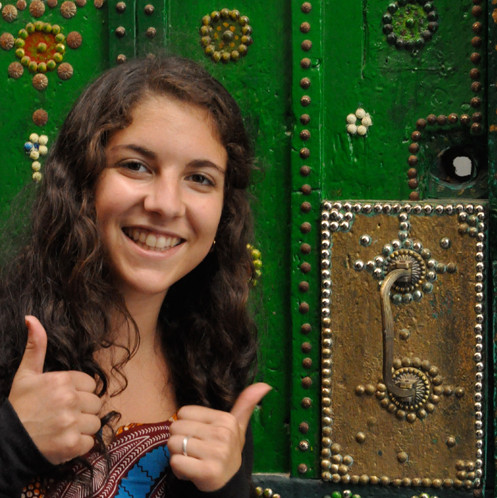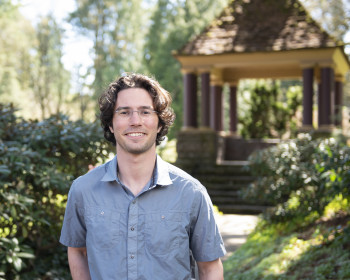Summer research students research effects of spider venom
Open gallery

At Lewis & Clark, summer doesn’t necessarily mean vacation. Many students spend up to 40 hours a week doing collaborative research with faculty each summer.
Matthew Sims ’13 and Maya Bendifallah ’13 are working alongside Associate Professor of Chemistry Nikolaus Loening to discover the effects of spider venom on crickets. The group is collaborating with colleagues in Australia who are conducting similar research. In this Q&A, the researchers reflect on the value of these experiences.
What are you researching this summer?
Sims: We are working to optimize the expression and purification of various spider toxins. Our goals are to classify the functional characteristics of different toxins. We hope to prepare samples of toxins for Nuclear Magnetic Resonance imaging. This will determine the molecular structures of these toxins, which will then provide useful insight into the functional mechanism by which these toxins work. We are using spider toxins collected in Associate Professor of Biology Greta Binford’s lab.
Bendifallah: We want to further improve the known protocols for processing venom toxins. We send off some purified protein samples to Dr. Loening’s colleagues in Australia to analyze how they affect neurons.
How do you think student-faculty collaboration has impacted your education?
Sims: Working with faculty guides you through the steps of becoming a capable experimental scientist. They are patient while you learn, but challenge you enough that you are learning an immense amount every single day. I already feel I have a deeper understanding of molecular biology and experimental science.
Bendifallah: I have greatly benefited from the one-on-one student-faculty interaction at Lewis & Clark. I find that having the ability to talk on a more personal level with my professors gives me an outlet for my questions and helps better connect me with the subject matter. It has made me more engaged in my schoolwork and given me the extra tools to tackle the intellectual challenges in my courses.
How do you hope your experience this summer will impact your future studies or professional pursuits?
Sims: I am confident that the experience of working in a lab as an undergraduate student will be beneficial when I start applying to graduate schools. By participating in research, I will better know the direction I will want to go in the future and what I am most interested in. After graduation, I plan on going to graduate school to obtain a master’s degree in metabolic biochemistry or biochemical engineering, applying for research internships in the Netherlands, or applying for the Teach for America program to teach science.
Bendifallah: I have decided that I don’t want to attend medical school, so this summer of research is a fantastic opportunity for me to explore some of my other options if I choose to continue in the biochemical field. I really enjoy the hands-on aspect of the lab, and working this summer is pushing me toward pursuing research professionally, if the opportunity arises.
How did you decide to attend Lewis & Clark?
Sims: When I visited Lewis & Clark as a junior in high school, I loved the campus so much that I toured it two more times. I instantly fell in love with the school and the spirit of the student body. I learned that the faculty members at Lewis & Clark are compassionate and challenging and that they would provide an atmosphere where I could learn a lot and become a critical thinker. My time at Lewis & Clark has been everything I’d hoped for.
About the program
The John S. Rogers Science Research Program allows students to participate in graduate-level research with an emphasis on strengthening their communication skills by requiring them to present their findings. This summer, 40 students are pursuing topics that range from cybersecurity to spider venom, and zebrafish to magnetic fields. Working closely with peers and faculty members, students undertake research questions and present their work in two public venues.
“We’re not asking you anymore, ‘What’s the answer,’ we’re saying ‘What’s the question,” said Michael Broide, director of the Rogers Program and chair of the physics department. “I think what sets our program apart is that regardless of what project you are on, we’re all going to come together as a group to present what we’re doing in as accessible a way as possible. In science, it’s such an important skill to be able to explain cogently what you’re doing.”
Students make their final research presentation at the Rogers Summer Science Poster session, held in conjunction with the Science Without Limits Symposium. Scheduled for September 18, the poster session is free and open to the public.
Zibby Pillote ’14 contributed to this story.
Opportunities in Science at Lewis & Clark
Read more about current research projects:
More Newsroom Stories
Public Relations is located in McAfee on the Undergraduate Campus.
MSC: 19
email public@lclark.edu
voice 503-768-7970
Public Relations
Lewis & Clark
615 S. Palatine Hill Road MSC 19
Portland OR 97219

